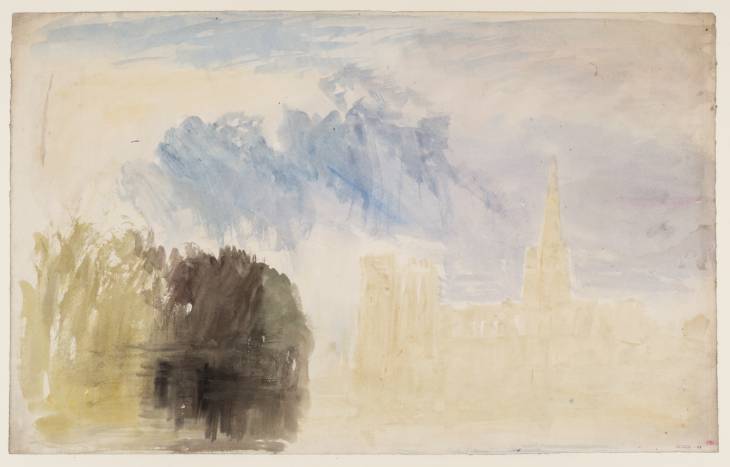Joseph Mallord William Turner ?Chichester Cathedral c.1828-38
Joseph Mallord William Turner,
?Chichester Cathedral
c.1828-38
Joseph Mallord William Turner 1775–1851
?Chichester Cathedral c.1828–38
D25204
Turner Bequest CCLXIII 82
Turner Bequest CCLXIII 82
Watercolour on white wove paper, 305 x 488 mm
Watermark ‘C Ansell | 1828’
Inscribed in red ink ‘82’ bottom right
Blind-stamped with Turner Bequest monogram towards bottom centre
Stamped in black ‘CCLXIII – 82’ bottom right
Watermark ‘C Ansell | 1828’
Inscribed in red ink ‘82’ bottom right
Blind-stamped with Turner Bequest monogram towards bottom centre
Stamped in black ‘CCLXIII – 82’ bottom right
Accepted by the nation as part of the Turner Bequest 1856
Exhibition history
1983
J.M.W. Turner: Studies for Finished Watercolours (c.1825–40): Watercolours from the Turner Bequest, Loaned by the British Museum, Tate Gallery, London, January–June 1983 (no catalogue).
1988
Summer Miscellany: Watercolours from the Turner Bequest, Tate Gallery, London, July–October 1988 (no catalogue, as ‘A Town, with a Church, from a River’).
References
1909
A.J. Finberg, A Complete Inventory of the Drawings of the Turner Bequest, London 1909, vol.II, p.820, CCLXIII 82, as ‘Town, with church spire, from the river’. c.1820–30.
1997
Eric Shanes, Turner’s Watercolour Explorations 1810–1842, exhibition catalogue, Tate Gallery, London 1997, pp.94 Appendix I under ‘Chichester Canal’, as ‘Chichester Cathedral?’, and under ‘Churches’, as ‘Chichester Cathedral?’, p.96 under ‘England and Wales Series’, as ‘?Sketch for a view of Chichester Cathedral, Chichester, Sussex’, p.105 Appendix II, as ‘Sketch: ?Chichester Cathedral’.
Eric Shanes has suggested that this colour study shows Chichester Cathedral, West Sussex, and that it represents an undeveloped subject for Turner’s Picturesque Views in England and Wales.1
The composition certainly represents a large church or cathedral with western towers and a central spire seen from the south, which correspond to those shown in Thomas Girtin’s (1775–1802) small watercolour of the cathedral of about 1797 (Tate D36633; Turner Bequest CCCLXXIX 7).
The composition certainly represents a large church or cathedral with western towers and a central spire seen from the south, which correspond to those shown in Thomas Girtin’s (1775–1802) small watercolour of the cathedral of about 1797 (Tate D36633; Turner Bequest CCCLXXIX 7).
Turner’s foreground is ambiguous, with the fluid horizontal strokes below the roughly indicated trees at the left suggesting reflections, hence Finberg’s description of the view as ‘from the river’. The River Lavant does flow to the south of the cathedral, albeit in a shallow, narrow channel. There are no identified Turner sketches to correspond with the prospect, and drawings showing (or possibly showing) details of the cathedral are limited to the Studies near Brighton sketchbook of 1796 (Tate D00764, D00766–D00768, D00783; Turner Bequest XXX 32a, 33, 33a, 34, 48), and a pencil study of the spire above the roofs of East Street, made in about 1800 (British Museum, London). The cathedral appears in the distance in the two versions of Chichester Canal, oil paintings made in the late 1820s for the Earl of Egremont (Tate N00560; Tate T03885, displayed at Petworth House, West Sussex).2 This might account for Turner’s renewed interest in the building at that time, assuming it is the subject of the present composition.
The identification as Chichester remains speculative; its dating to around 1828–38 takes into account the sheet’s 1828 watermark and the termination of the England and Wales project some ten years later. It has been tentatively suggested that Tate D25227 (Turner Bequest CCLXIII 105) might be another study for the subject. See also the introductions to the present subsection of identified but unrealised subjects and the overall England and Wales ‘colour beginnings’ grouping to which this work has been assigned.
Verso:
Blank, save for inscriptions: stamped in black with Turner Bequest monogram above ‘CCLXIII – 82’ bottom left; in pencil ‘24’ centre right, upside down; and in pencil ‘AB 150 P’ and ‘CCLXIII 82’ bottom right.
Blank, save for inscriptions: stamped in black with Turner Bequest monogram above ‘CCLXIII – 82’ bottom left; in pencil ‘24’ centre right, upside down; and in pencil ‘AB 150 P’ and ‘CCLXIII 82’ bottom right.
The ‘AB’ number corresponds with the endorsement on one of the parcels of works sorted by John Ruskin during his survey of the Turner Bequest, in this case classified by him as ‘Colour dashes on white. Valueless’.1
Matthew Imms
March 2013
How to cite
Matthew Imms, ‘?Chichester Cathedral c.1828–38 by Joseph Mallord William Turner’, catalogue entry, March 2013, in David Blayney Brown (ed.), J.M.W. Turner: Sketchbooks, Drawings and Watercolours, Tate Research Publication, December 2013, https://www

